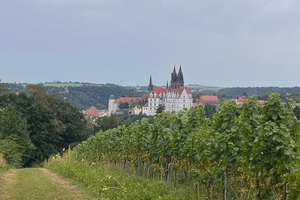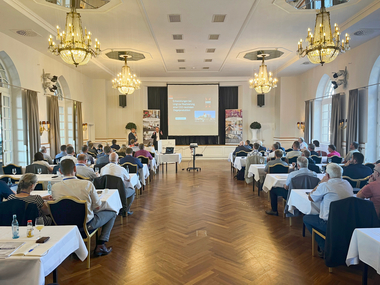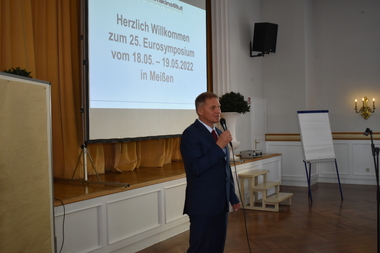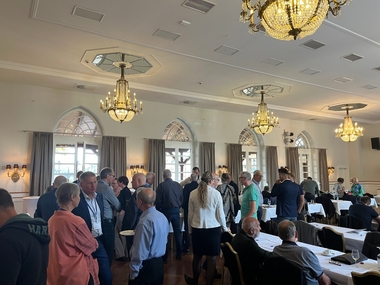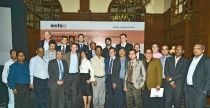Review of the 28th Euro Symposium in Meissen – ‘Clay – Rock of the Year 2025’
The 28th Euro Symposium of the KI Ceramics Institute in Meissen took place on 10 and 11 September 2025. As in previous years, participants met on both days for the lecture programme in the conference hall of the Romantik Hotel Burgkeller at the top of Meissen‘s castle hill. On the evening of the first day, as always, the KI invited participants to a joint evening programme in the vicinity of the Saxon porcelain town.
The lecture programme was preceded by a small snack to fortify the arrivals. Dr Jens Petzold, Managing Director of the Ceramics Institute, opened the conference and welcomed the participants together with the Mayor of Meissen, Markus Renner.
The conference began with the lecture ‘Tradition meets transformation: bricks in tomorrow‘s Europe’. Attila Gerhäuser, Managing Director of the Federal Association of the German Brick and Tile Industry, Berlin, gave an overview of the situation in the industry. Despite initial signs of improvement, the market situation remains tense. In addition to important political processes at federal and European level, he also highlighted technical approaches and flagship projects for the climate-neutral transformation of brick production.
Bert Vulpius, Managing Director of the Association of Mineral Building Materials Manufacturers (UVMB) in Berlin, discussed the ‘Requirements for securing raw materials and their implementation in central Germany’. Vulpius presented the federal legal basis for securing raw materials in the Federal Spatial Planning Act. Its implementation in the state development and regional plans of Saxony-Anhalt, Saxony and Thuringia was presented and evaluated in detail.
After the coffee break, Richard Soltau, Managing Director of Golem – Kunst und Baukeramik GmbH in Sieversdorf, explained ‘The beginnings of industrial floor tile production in Germany’. The company itself specialises in the traditional manufacture of this building material. Soltau explained the political, economic, social and technical conditions under which the floor tile industry developed, as well as its historical precursors.
Proschwitz Castle in the north of Meissen provided the festive setting for the evening event. Participants enjoyed the winery‘s products and a guided tour of the castle and park. A buffet dinner brought the evening to perfection.
The lecture programme on the second day began with Paul Manß, production manager at Porzellanmanufaktur Kahla/Thüringen GmbH. He spoke about ‘Clay – a sustainable raw material: challenges and opportunities in the porcelain industry’. The former include production conditions with their consequences in terms of open-cast mining, transport and process heat, while the latter include the development of new firing technologies, energy efficiency measures and 3D printing. Sustainable consumption of porcelain also represents an opportunity.
‘Redox ceramics made of perovskite as hybrid thermochemical heat storage devices’ was the topic of the presentation by Klaus Hantzsch from KI Keramik-Institut GmbH, Meissen. Perovskite is characterised by a very high specific heat capacity and a tendency to undergo redox reactions in certain compounds. These compounds can be produced using ceramic processes and shaped into forms suitable for the application.
Sandra Lehmann from Chemex Foundry Solutions GmbH in Delligsen discussed the ‘Development of a refractory raw material as an alternative to fly ash’. Thanks to the spread of alternative power generation methods, the volume of fly ash is decreasing and its quality is changing. This means that sectors that use fly ash as a raw material are being forced to develop alternatives. Chemex has developed an alternative refractory filler for feeders, a foundry auxiliary.
In the final presentation of the conference, EurGeol Dr Lutz Krakow from Dr Krakow Rohstoffe GmbH, Göttingen, presented ‘Practical examples of the use of fine-grained surplus minerals in building ceramics’. Due to growing restrictions on raw material extraction and in the interest of complete utilisation of deposits, fine-grained components in natural stone quarries and in gravel and sand pits are becoming increasingly relevant. He argued that these raw materials are very well suited for use in building ceramics.
At the end of the Euro Symposium, Dr Petzold invited all participants to a joint lunch and to the next Euro Symposium on 15 and 16 September 2026.





